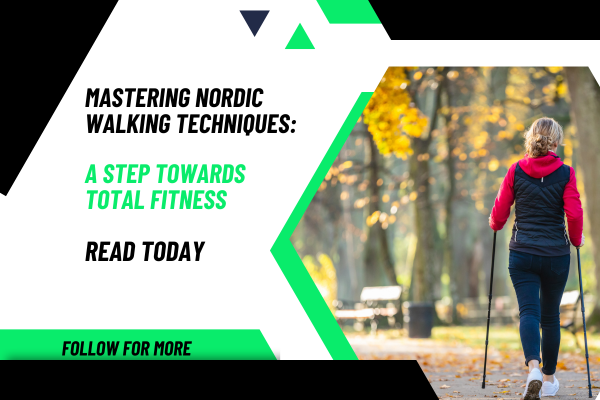Mastering Nordic Walking Techniques: A Step Towards Total Fitness

Nordic Walking has gained immense popularity as a total-body workout that combines the simplicity of walking with the added benefits of using poles.
This fitness trend, which originated in Finland, has spread worldwide due to its effectiveness in improving cardiovascular health, muscle strength, and overall well-being.
In this comprehensive guide, we will delve into the art of Nordic Walking, understanding its techniques, and exploring how it can be incorporated into your fitness routine.
Understanding Nordic Walking
Nordic Walking is a full-body exercise that involves walking with specially designed poles.
These poles are used to propel yourself forward, engaging the upper body in addition to the lower body's natural walking motion.
It transforms an ordinary walk into a dynamic, calorie-burning, and muscle-toning workout.
The Benefits of Nordic Walking
- Enhanced Cardiovascular Fitness: Nordic Walking increases your heart rate and oxygen consumption, improving cardiovascular health.
- Full-Body Workout: It engages the muscles of the arms, shoulders, chest, and core, providing a comprehensive workout.
- Improved Posture: Proper Nordic Walking technique encourages good posture and spinal alignment.
- Joint Health: The use of poles reduces the impact on joints, making it suitable for people of all fitness levels.
Key Nordic Walking Techniques
- Pole Placement: Plant the poles diagonally behind you, allowing them to push you forward as you walk.
- Grip and Wrist Movement: Maintain a relaxed grip on the poles and utilize a wrist flick to propel yourself.
- Stride Length: Keep your strides natural and in sync with your arm movements.
- Upright Posture: Maintain an upright posture with a slight forward lean from the ankles.
Getting Started with Nordic Walking
- Equipment: Invest in proper Nordic Walking poles that are the right height for you. They should allow your elbows to bend at a 90-degree angle while holding them.
- Footwear: Wear comfortable, supportive walking shoes.
- Choose Your Terrain: Nordic Walking can be done on various terrains, from sidewalks to trails. Start on level ground and gradually progress to more challenging surfaces.
Safety Considerations
- Learn Proper Technique: Consider taking lessons or watching instructional videos to master the correct Nordic Walking technique.
- Start Slowly: Begin with shorter walks and gradually increase the duration as your fitness level improves.
- Stay Hydrated: Drink water before, during, and after your Nordic Walking sessions, especially in warm weather.
Nordic Walking vs. Regular Walking
Nordic Walking offers several advantages over traditional walking:
- Engages the upper body, providing a full-body workout.
- Increases calorie burn.
- Reduces stress on joints.
- Improves posture and core strength.
Nordic Walking for Different Fitness Goals
- Weight Loss: Incorporate Nordic Walking into your weight loss journey to burn extra calories and tone muscles.
- Cardiovascular Health: Regular Nordic Walking can significantly improve heart health and circulation.
- Muscle Toning: Utilize the upper body engagement to tone your arms, shoulders, and core.
Sample Nordic Walking Workouts
- Basic Nordic Walking: A 30-minute walk in your local park with proper technique.
- Interval Nordic Walking: Alternate between brisk walking and slow-paced recovery walks.
- Hiking with Poles: Take your Nordic Walking to the trails for a more challenging workout.
Nutrition and Recovery Strategies
Maintain a balanced diet, stay hydrated, and stretch your muscles after your Nordic Walking sessions to aid recovery.
Monitoring and Tracking Progress
Keep a journal of your walks, noting distance, duration, and how you feel.
This helps track your progress over time.
Common Myths About Nordic Walking
Myth: Nordic Walking is only for older adults.
- Reality: Nordic Walking is suitable for people of all ages and fitness levels.
Myth: It's just walking with sticks; there's nothing special about it.
- Reality: Nordic Walking provides a unique full-body workout that regular walking cannot match.
Success Stories
- John: Lost 30 pounds and improved his overall fitness by incorporating Nordic Walking into his daily routine.
- Sarah: Overcame lower back pain and improved her posture through regular Nordic Walking.
The Future of Nordic Walking
As awareness of the benefits of Nordic Walking continues to grow, it is likely to become an even more popular fitness option.
Innovations in equipment and training techniques may further enhance its effectiveness.
Conclusion
Nordic Walking is a simple yet highly effective fitness activity that offers a wide range of benefits.
By mastering the proper techniques and incorporating it into your regular routine, you can enjoy improved cardiovascular health, enhanced muscle strength, and overall physical well-being.
Whether you're a fitness enthusiast or looking for a low-impact workout, Nordic Walking is an accessible and enjoyable way to stay active.
FAQs
Do I need special Nordic Walking poles, or can I use regular hiking poles?
While regular hiking poles can be used, Nordic Walking poles are designed specifically for the activity and provide better results.
Is Nordic Walking suitable for people with joint issues or injuries?
Nordic Walking is often recommended for individuals with joint issues or injuries, as it reduces impact on the joints compared to traditional walking or running.
However, consult with a healthcare professional before starting any new fitness routine, especially if you have existing health concerns.
